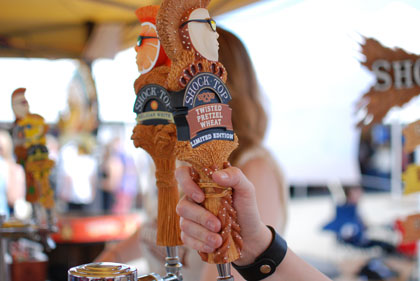MONDAY BEER LINKS, MUSING 05.12.14
As Craft Beer Starts Gushing, Its Essence Gets Watered Down. When NPR speaks, people listen — and so my friends who live blissfully in a world where the question “What is craft beer?” is not debated every day email me the story. It is a reminder that in the real world “craft verus crafty” gets attention and a headline that contends “its essense gets watered down” becomes fact rather than a subject for discussion.
In the story — if you somehow managed to miss it — Dan Del Grande at Bison Organic Beer says he doesn’t think the Brewers Association should have changed its definition of “craft brewery” to include those that use adjuncts and and those that “make more than about 200,000 barrels of beer per year should not be recognized as craft.” (I added the boldface.) If you can’t get enough of the discussion about trade associations, who is on whose side, and the meaning of “craft” then head right on to the next link after this one.
Total aside, you have to smile when a beer geek conversation breaks out rather early on in the comments, beginning with brandon east writing, “Dude, what are you doing? Look to your right and get that four-pack of Bourbon County Brand Stout!”
[Via The Salt]
Brewers, Distillers Wrestling with Meaning of ‘Craft.’ A report from a panel discussion at the Craft Beverage Expo in San Jose last week, the panel including brewers, distillers and a winemaker. I’m not sure which of these words can get you in more trouble: traditional or practical.
So this from winemaker Alie Shaper and you can read the rest yourself: She said winemakers don’t use the “c word” but often refer to themselves as “artisanal” or “family-owned.” “An artisanal winery has a lead winemaker who is there to put personality in their production,” she said. “Maybe that is the real definition of craft. Some people want to stay smaller and some want to get bigger.”
[Via Brewbound]
Belgium’s craft brewers sound the alarm. The discussion here is about real brewers and “fake brewers” in Belgium, although rather obviously this impacts the idea of brewing as craft. A translation of an open letter from a group of Belgian brewers includes this rather shocking nugget:
“These days, thanks to a growing interest in beer at home and abroad, a new ‘brewery’ opens up in this country roughly every 15 days. We estimate that around 75% of these businesses are breweries in name only, and that no beer is actually produced by the businesses themselves.”
It’s complicated and worth your time to read the whole thing. Commenting on it at I might have a glass of beer, Rob Sterowski wrote, “It’ll be interesting to see whether beer geeks in the rest of the world pay any attention to the opinions of the brewers they claim to revere so much.”
Sorry, no link, but the second issue issue of Belgian Beer & Food, a new publication, includes an article by Joe Stange (“When is a Brewery Not a Brewery? And Does it Matter?”) that provides more context.
[Via Belgian Beer & Food]
What’s Oregon’s healthiest beer? Deschutes, Hopworks and other breweries seek an unusual title. And you thought “craft” was tough to define. [Via Portland Business Journal]
Ale brewing in the USA and Canada in 1907. With a pretty bold conclusion from Ron Pattinson: “The cross-fertilsation of ideas from British Ale brewing and Continental Lager brewing seems to be the defining feature of North American brewing.” [Via Shut Up About Barclay Perkins]
 Boak & Bailey have stepped up to host The Session #88 (somehow we were lacking a volunteer), scheduled for June 6, personally noteworthy date for two reasons. First, it will be the 70th anniversary of D-Day, and we were backpacking in England for the 50th, enjoying seeing veterans in old uniforms visit seaside towns. Second, because Amazon says I might have Boak & Bailey’s
Boak & Bailey have stepped up to host The Session #88 (somehow we were lacking a volunteer), scheduled for June 6, personally noteworthy date for two reasons. First, it will be the 70th anniversary of D-Day, and we were backpacking in England for the 50th, enjoying seeing veterans in old uniforms visit seaside towns. Second, because Amazon says I might have Boak & Bailey’s 